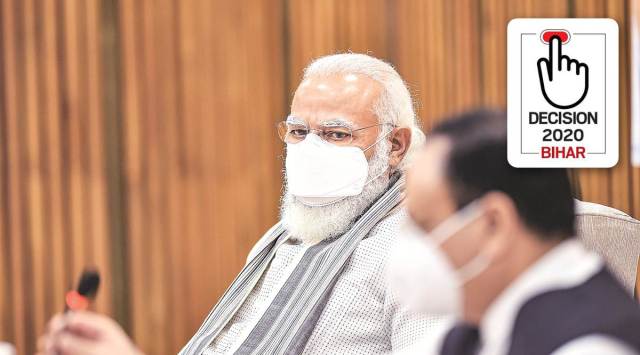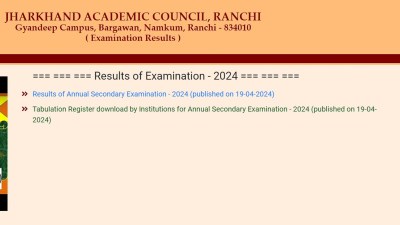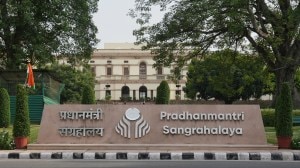- India
- International
Battle for Bihar: Why it matters
It is India’s first mass polls in the shadow of the pandemic, and Bihar’s first in a long, long time without either Lalu Prasad or the just deceased Ram Vilas Paswan present. Nitish Kumar, meanwhile, has conceded much ground in his alliance with Narendra Modi’s BJP.
 PM Modi at a BJP meeting to decide candidates in Delhi on Saturday. Apart from a vote on the lockdown and economy, Bihar is important for BJP politically. (PTI)
PM Modi at a BJP meeting to decide candidates in Delhi on Saturday. Apart from a vote on the lockdown and economy, Bihar is important for BJP politically. (PTI)The chessboard is set, the sides have been chosen, the backchannels are over, and the battle lines drawn. In a state that has always been watched for what its social and political undercurrent signify, Election 2020 is being keenly watched. It is India’s first mass polls in the shadow of the pandemic, and Bihar’s first in a long, long time without either Lalu Prasad or the just deceased Ram Vilas Paswan present. Nitish Kumar, meanwhile, has conceded much ground in his alliance with Narendra Modi’s BJP.
The importance of Bihar
Historically, Bihar has been a cradle of grass-root political and social movements, including Jayaprakash Narayan’s Total Revolution that shook the mighty Indira Gandhi government, and led to the imposition of Emergency and the first non-Congress government at the Centre in 1977. The coalition of anti-Congress forces sowed the seeds of social justice politics, and gave Bihar leaders like Nitish Kumar, Lalu Prasad and Sushil Kumar Modi — though the three now stand in different political corners. In 1977, Bihar chief minister Karpoori Thakur implemented the Mungerilal Commission’s recommendations, providing for reservations for the backward castes in jobs and educational institutions. The churning set in motion the assertion of backward castes in national politics, which has lasted four decades. Could the BJP with its larger Hindutva narrative override that?
The importance of Bihar polls
India’s third most populous state, it was home to 10.4 crore people in the 2011 Census. This election, about 7.29 crore will be eligible to vote — more than the populations of countries like the UK, France or Italy. It also lags behind most of India on many social indicators, causing its youth to seek out jobs and hence carry their imprint across the country. Since the lockdown, many have returned.
In 2015, Bihar dealt one of the biggest blows to the then seemingly invincible Modi juggernaut. But, this time, Nitish’s JD(U) is with the BJP and there is no Lalu around. Could Bihar, still, spring a surprise?
Read | WhatsApp chain down to booths, FB Live with Nitish slogan: @JDU
The impact of the pandemic

At 56.8%, Bihar saw its highest-ever voter turnout in 2015. While Election Commission has put coronavirus precautions in place, will it be enough to get adequate numbers to the booths? Could a low turnout be a further disadvantage for the Opposition, given the BJP’s committed cadre? Or will there be more of a dip in urban voting, where the BJP is strong?
Digital campaign
A predominantly rural state, Bihar will witness the most digital-driven campaign in India’s history. Leaders of major parties have already held virtual rallies (with the BJP leading the way), and the familiar sight of huge poll gatherings is likely to be missing. Could the migrants who are home (an estimated 25 lakh) prove decisive, given their familiarity with digital compared to others?
The alliance math
Down to the wire, leaders with caste vote bases have switched sides — the LJP is out of the NDA alliance, but its target is only the JD(U), not BJP; while Upendra Kushwaha’s Rashtriya Lok Samata Party (RLSP), Mukesh Sahni’s Vikassheel Insaan Party (VIP), and Jitan Ram Manjhi’s Hindustan Awami Morcha (HAM) have exited the Mahagathbandhan. As the VIP and HAM move to the NDA and the RLSP floats a third front with the BSP and AIMIM, all the above developments could end up helping BJP.
While the RJD, with CM ambitions for Tejashwi Yadav, has got the alliance it wanted, tying up with the Congress and three Left parties and retaining its pre-eminent position, the Congress wanted a more broad-based coalition. However, in the bargain, the Congress has got 70 seats — far more than the 41 last time. With the Congress winning around half then, and the party as much of a cipher on the ground, could RJD calculations lie in the seats (read difficult) Congress gets?
The Modi factor
In the 2019 Lok Sabha polls that the Modi-led BJP swept, the NDA alliance (including the JD-U and LJP) had won all but one of the 40 seats in Bihar. The Congress had won the remaining one. However, since then, the BJP has lost Jharkhand, Delhi and Maharashtra, and has been dented in Haryana. Plus, Bihar saw among the largest migrants return home in the lockdown. However, will that prove enough against Modi’s popularity?
The migrant vote | Hit by floods, pandemic, Seemanchal residents head out for work, ask where are jobs, factories
‘Sushasan Babu’s’ credibility
Nitish has been CM for 15 years now, a longevity sustained by his image of ‘Vikas Purush’, as opposed to Lalu’s ‘Goonda Raj’. However, the memory of his pole vaults since 2014 — sullen resignation as CM after the JD(U)’s Lok Sabha rout in 2014, switch to Lalu to form an unlikely Mahagathbandhan, and an even more unlikely turnaround to embrace the BJP in 2017 and stay in power —lingers. While astute, the metamorphoses might have been one too many in this deeply political state. Nitish is also up against mounting anti-incumbency, with his government seen as stumbling on jobs, coronavirus and floods. Could Nitish’s slogan of his 15 years against 15 years of Lalu be potent enough?
Lalu’s absence
For three decades, politics in Bihar revolved around the RJD supremo, with Assembly polls fought either to bring him to power, or keep him out. Tejashwi, emerging from a bruising family tussle, is far from his father’s shadow. Last month, Lalu’s long-distance lieutenant Raghuvansh Prasad Singh quit the RJD, in what would be his last days, over how the party was being run. The exits of crucial caste partners RLSP, HAM and VIP have followed. Sources said Tejashwi believes these smaller parties are not able to transfer their votes, and their MLAs are vulnerable to post-election poaching attempts.
However, 31-year-old Tejashwi’s lack of administrative experience weighs against him, especially in the context of Nitish’s governance plank. Lalu, who remains in jail, can’t lend the charisma that earlier helped overlook that. Does he still wield enough sway?
The Muslim vote
Traditionally, the Muslims in Bihar have formed one leg of Lalu’s MY plank (the second being Yadav). However, sidelined under the Modi government, alienated over legislation like the CAA and plans for an NRC, wary after the Delhi riots, and disappointed by Ayodhya verdicts, the Muslims in Bihar may be ready to embrace someone else. Firebrand AIMIM leader Asaduddin Owaisi sees an opening, and has announced plans to contest across Bihar. While it had only won one of the six constituencies it fought in 2015, the AIMIM sounded its arrival with the Kishanganj bypoll win in October last year. The AIMIM has tied up with the RLSP, BSP and former RJD MP Devendra Prasad Yadav’s Samajwadi Janata Dal (Democratic).
Tejashwi’s silence in the wake of the Babri case acquittals has also been noted. It was Lalu who as CM had stopped L K Advani’s Rath Yatra in October 1990. Does enough of the goodwill Muslims have for the RJD linger?
The Dalit vote
The SCs constitute about 16% of the state’s population, with Paswans (about 5.5%) and Ravidas (about 4%) the largest blocks. When Lalu was at his peak, the RJD enjoyed the backing of most OBC groups, Muslims and Dalits. Over the years, Nitish has managed to split that with his EBC-Mahadalit focus.
But now the matrix is all mixed. The LJP is not in the NDA alliance “but with Modi”; Manjhi, the tallest Musahar leader (2.5% of the state population) has pitched his pole in the NDA tent; the RJD has got back former state minister Shyam Rajak with an eye on the Dalit votes; and crowding the poll fray are Chandrasekhar Azad’s Bhim Army and the BSP.
While the BSP is a marginal player in Bihar, in areas like Sasaram, Buxar and Aurangabad, partner RLSP will add to its numbers. The RLSP, headed by former union minister Upendra Singh Kushwaha, claims the support of the Kushwahas (including Koeris, around 8% of Bihar’s population).
The VIP’s Mukesh Sahani brings to the BJP the Mallah votes, which will prove crucial in the tightly contested riverine seats.
Tejashwi has tried to woo back the non-Yadavs, with not-so-fond memory of Lalu rule, by apologising for mistakes then. In the run-up to the polls, the Congress is likely to play up the assault leading to the death of a Dalit woman in Hathras, including the Yogi government’s ham-handed handling of the episode. Will that prove enough of a caste pull?
The national message
How Bihar votes, will be a signal not just for Modi, NDA’s star campaigner — whatever the noises made about Nitish — but also the Opposition. The result will be seen as a reflection on Modi government’s handling of the pandemic and management of the economy.
Plus, it could be a factor in West Bengal, a state the BJP has set its eyes on and which votes next, in April-May 2021.
Apr 19: Latest News
- 01
- 02
- 03
- 04
- 05






































